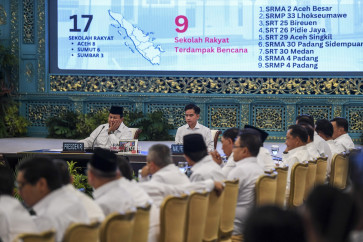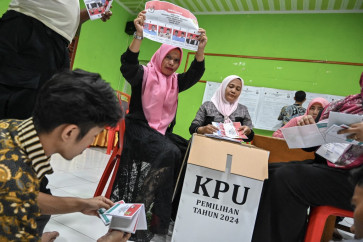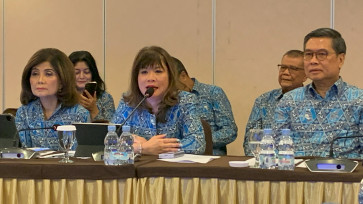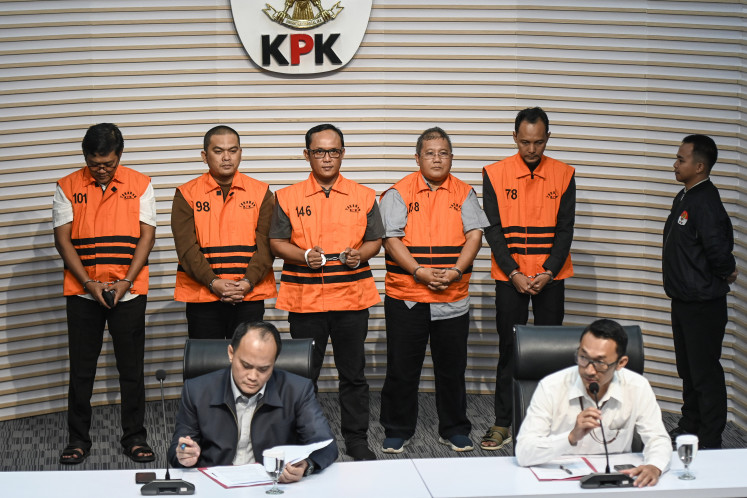Popular Reads
Top Results
Can't find what you're looking for?
View all search resultsPopular Reads
Top Results
Can't find what you're looking for?
View all search resultsIndonesia’s EV momentum and the questions we forget to ask
If the local EV plant operates mainly as an assembly site, while key components, technologies and decisions remain imported, then Indonesia risks staying an import-based market.
Change text size
Gift Premium Articles
to Anyone
I
ndonesia is pushing hard on vehicle electrification. The numbers are bold: From just 14,000 domestically produced electric vehicles in 2022, the figure is projected to reach 374,000 by year-end.
Nearly Rp 20 trillion in new investment is expected. Presidential Regulation No. 79/2023 lays out a clear roadmap, Local Content Requirements (TKDN), tax incentives and production guarantees. The transition from completely built-up (CBU) to completely knock-down (CKD) is underway.
Industry players are responding. Job prospects are expanding. These are visible movements. And as a national effort, it deserves an acknowledgement.
But visibility is not the same as clarity. The numbers show motion. Whether they show direction, or intention, is a different question.
The EV Tech Summit presentation from the Office of Coordinating Minister for Infrastructure and Regional Development makes a strategic pivot: It does not primarily frame EVs as a carbon solution, but as a sovereignty tool.
The argument is clear, Indonesia imports oil and LPG, but electricity is generated domestically. Electrifying transport reduces dependence on volatile global fuel markets. This reframing is one of the strongest elements of the presentation, and it should be credited. It reframes the transition from climate-driven to trade-driven, still valid, and possibly more politically grounded.
The document also highlights Indonesia’s vast renewable potential, especially solar, estimated at 155 Gigawatts. It implies that this potential could one day support the electrified vehicle fleet cleanly.
However, that potential remains largely untapped. The presentation does not map a policy mechanism to accelerate grid decarbonization in parallel with vehicle electrification. It offers no assurance that the new demand from EVs will be met by renewables.
In its current state, Indonesia’s electricity generation is still heavily reliant on coal. As a result, EVs may become just another fossil-fueled load, transferring emissions from the tailpipe to the smokestack.
What is also missing is urban mobility logic. The document does not address public transportation, city redesign or transport equity. There is no mention of how EVs will be integrated with mass transit systems, rural access strategies or emissions zoning. The narrative is focused entirely on replacing internal combustion with electric motors, without asking how people move, why they move or whether electrification will be equitably distributed.
On employment, the document highlights important macroeconomic figures: over 1.5 million people already work in Indonesia’s automotive industry, and the sector contributes more than Rp 190 trillion to GDP. These are serious numbers, and they reflect a real backbone of the economy. It also shows that Indonesia leads ASEAN in car sales.
But the employment argument is framed through scale, not structure. Nowhere does the presentation explore how the labor force will be upskilled for EV-specific competencies, such as battery systems, embedded software, power electronics or safety testing. There is no mention of vocational pathways, technical certification programs or R&D investment in universities.
In short, it does not yet describe a strategy to turn today’s workforce into tomorrow’s engineers. And while no country begins with high-tech capacity, the transition from assembler to innovator must be planned, not assumed.
On sovereignty, the policy mechanisms are more structured. Presidential Regulation 79/2023 establishes mandatory local content targets: 40 percent by 2026, 60 percent by 2029 and 80 percent thereafter. It requires manufacturers to provide production guarantees equivalent to the number of EVs they import.
These targets are tied to tax incentives, reduced value-added tax and luxury tax (PPnBM), and enforced via bank guarantees. This system of incentives and penalties is far from symbolic. It is a real attempt to localize industrial control.
But sovereignty must be understood carefully. Local content targets measure where production happens, not necessarily who owns the technology, designs the systems or controls the supply chain. A country can assemble what it does not command. A factory onshore does not automatically mean decision-making onshore.
The summit presentation does not yet address upstream control, who owns the battery design, who sets software standards, who controls the mining-to-manufacturing flow. Sovereignty without these levers may remain performative.
One Chinese manufacturer, BYD, has seven months left to fulfill its commitment to build a plant in Indonesia. If it delivers, that will be a milestone. But presence alone is not the same as depth.
If the local plant operates mainly as an assembly site, while key components, technologies and decisions remain imported, then Indonesia risks staying an import-based market in structure, even if the factory stands on local soil.
What matters is not just location, but control over the supply chain. Without that, we may move from importing finished vehicles to importing kits, tools and even instructions, never escaping the boundaries of dependence.
So what problem are we solving?
If the goal is to reduce emissions, then EVs must be tied to a decarbonized grid, and transport policies must include public mobility and system equity. If the goal is to expand employment, then the country must invest not only in how many people are hired, but how their skills evolve.
That pathway can begin with manual execution and assembly-line training, but it must also plan for capability-building in diagnostics, systems integration and materials science. If the goal is sovereignty, then factories must be followed by learning curves, standards ownership and the ability to shape, not just receive, the global EV roadmap.
Indonesia deserves credit for initiating a serious, structured industrial effort. The regulation is not empty. The momentum is real. But if electrification becomes the end in itself, rather than a lever for broader transformation, we may confuse volume for progress.
Electrification is not the problem. The concern is when it becomes the only focus. The larger question is whether this effort leads to structural transformation, or simply another layer of dependency.
The task now is not just to adopt what works elsewhere, but to make sure that we define what works here. Not just to produce what others design, but to make sure we do not remain dependent on other countries for parts, tools or technology.
***
The writer is the Bandung Institute Technology’s 2025 Ganesa Widya Jasa Utama awardee and En-Roads Climate Simulation ambassador. The views expressed are personal.
Your Opinion Matters
Share your experiences, suggestions, and any issues you've encountered on The Jakarta Post. We're here to listen.
Thank you
Thank you for sharing your thoughts. We appreciate your feedback.











